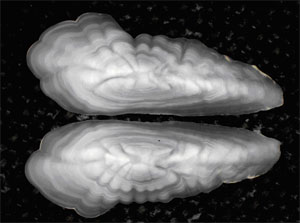

MESA: Sablefish Life History
|
Sablefish otoliths used for determining age.
(Photo courtesy of D. Anderl) |
Sablefish are a long-lived species with fish over age 40 years commonly found in commercial samples. The maximum reported age in Alaska is 94 years, in Canada is 55 years, and in Southeast Alaska inside waters the maximum age is 65 years (from ADF&G survey data, 1988-2001). However, because sablefish are difficult to age, these ages are approximate.
In the Gulf of Alaska, adult sablefish may reach a maximum length and weight of 88 cm and 6.8 kg respectively for males and 110 cm and 14 kg for females. Fifty percent of males are mature at 57 cm (5 years) and fifty percent of females are mature at 69 cm (6.5 years).
Spawning occurs pelagically at depths of 300-500 m near the edges of the continental slope. Eggs develop at depth and larvae develop near the surface up to 180 miles offshore. The average spawning date, based on otolith analysis, is March 30. During surveys of the outer continental shelf, most young-of-the-year sablefish were caught in the central and eastern Gulf of Alaska. Near the end of the first summer, pelagic juveniles less than 20 cm drift inshore and spend the winter and following summer in inshore waters, reaching 30-40 cm by the end of their second summer. After their second summer, they begin moving offshore, typically reaching their adult habitat, the upper continental slope, at 4 to 5 years.
Adult sablefish are opportunistic feeders, preying on fish (including pollock, eulachon, capelin, herring, sandlance, and Pacific cod), squid, euphausiids, and jellyfish. Yearling sablefish primarily feed on euphausiids. Juvenile sablefish are eaten by adult coho and chinook salmon.
Contact:
Dana Hanselman
Auke Bay Laboratories
Alaska Fisheries Science Center, NOAA Fisheries
Ted Stevens Marine Research Institute
17109 Pt Lena Loop Rd
Juneau AK 99801
Dana.Hanselman@noaa.gov
|

